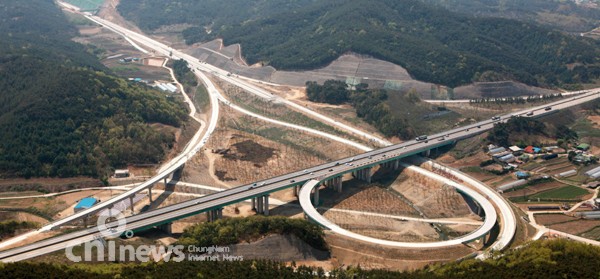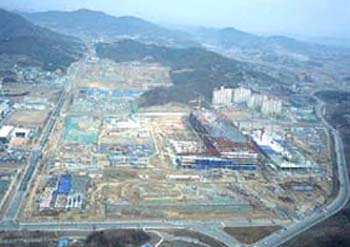About Chungnam
News
Chungnam, the Core Axis of Korea’s Growth
The Home to New High-tech Industrial Clusters
2009.08.21(금) | CNnews (![]() chungnamdo@korea.kr)
chungnamdo@korea.kr)
Chungnam is rapidly rising as a new high value high-tech industrial cluster, due to lead national growth in Korea.
Including the display cluster from Cheonan to Asan and creating the industrial belt covering automobiles, iron manufacture, oil and precision chemistry complexes, the region has worked hard to make its place as the home to all these high-tech businesses. With existing and expected traffic networks, including the West Coast Highway and the highway from Daejeon to Dangjin due in 2008, large ports, and industrial complexes, it is experiencing changes and growth every day.
Chungnam Crystal Valley, Home to the Display Industry
In an attempt to foster the display industry, one of the growth momentum industries of the future in the region, Chungnam Province started its investment plan last year, which is to spend 169 billion won by 2008. The Crystal Valley accounts for about 35% of the total production of Korea’s display products and 49.8% of its exports. The region foresees a concentration of major players in the business including Samsung Electronics.
Chungnam Province is determined to bring up the region as the world’s largest display cluster. For this goal, it has worked on a total of nine complexes (3.62 million pyeong) including the Asan Tangjeong Complex 1 and 2, which will be the world’s biggest module production complex over an area of 1.38 million pyeong, the Asan Techno Valley where a host of production equipment and parts manufacturers gather around over an area of 720,000 pyeong, and the R&D complex around Asan Tangjeong.
Seosan, the Hub City of the Automobile and Parts Industry
With the establishment of the automobile industry-based Seosan Technopolis, the Seosan area has begun to serve as the central place for automobile companies scattered around the area, and to become a competitive cluster.
A group of small and big car parts manufacturers have moved in the area since the Hyundai Motor Company settled down there, which is one of the results of the project of developing the area as the home to the automobile industry. Chungnam Province is planning to invest a total of 72.8 billion won into a total of nine projects by 2009 in order to improve the R&D concentration and competitive edge of the automobile and parts industry in the region.
Dangjin, the Steel Company City
Riding on the Seokmun tide embankment, you will see major steel companies including Hyundai Hysco, Hyundai Steel, Dongbu Steel, and Dongguk Steel standing at the gate of Dangjin, the new up-and-coming steel city.
The six steel companies running business in the city produce 10.85 million tons of steel per annum. The production combined will reach 20 million tons annually in 2011 when Hyundai steel completes the Ilgwan steel mill and Dongguk Steel completes its new plant. With such a capacity, Dangjin will surpass Pohang and Gwangyang as the biggest steel-producing city in Korea. Leading the steel industry in the area is Hyundai Steel. Once it completes its new steel mill in 2001 and runs its new 12 million-ton system, it will become the world’s sixth largest steel company with crude steel production of 22.50 tons per annum.
Daesan Oil Complex, the Mecca of the Petrochemical Industry
Hosting the nation’s major oil companies such as Samsung Total Petrochemicals, LG Chem, Lotte Daesan Petrochemical Corp., Samsung Petrochemical, and Hyundai Oilbank, the Daesan Oil Complex is pursuing its dream to become the biggest oil complex in the nation by taking advantage of its proximity to the Seoul Metropolitan Area and China, its two biggest markets, and also by takingadvantage of its low logistic costs.
It expects its logistics conditions to improve even further, and there is a good reason for such an expectation; the Daesan Port is under construction. Once it is completed in 2011, it will be able to deal with two 20,000-ton ships at the same time. It will also contribute to increasing the competitive edge of the petrochemical products exported in containers rather than in liquid products. Taking into accounnt these promising results, the oil companies in the area are active in planning and building new facilities and expanding their complexes.
Including the display cluster from Cheonan to Asan and creating the industrial belt covering automobiles, iron manufacture, oil and precision chemistry complexes, the region has worked hard to make its place as the home to all these high-tech businesses. With existing and expected traffic networks, including the West Coast Highway and the highway from Daejeon to Dangjin due in 2008, large ports, and industrial complexes, it is experiencing changes and growth every day.
 |
||
Chungnam Crystal Valley, Home to the Display Industry
 |
||
In an attempt to foster the display industry, one of the growth momentum industries of the future in the region, Chungnam Province started its investment plan last year, which is to spend 169 billion won by 2008. The Crystal Valley accounts for about 35% of the total production of Korea’s display products and 49.8% of its exports. The region foresees a concentration of major players in the business including Samsung Electronics.
Chungnam Province is determined to bring up the region as the world’s largest display cluster. For this goal, it has worked on a total of nine complexes (3.62 million pyeong) including the Asan Tangjeong Complex 1 and 2, which will be the world’s biggest module production complex over an area of 1.38 million pyeong, the Asan Techno Valley where a host of production equipment and parts manufacturers gather around over an area of 720,000 pyeong, and the R&D complex around Asan Tangjeong.
Seosan, the Hub City of the Automobile and Parts Industry
With the establishment of the automobile industry-based Seosan Technopolis, the Seosan area has begun to serve as the central place for automobile companies scattered around the area, and to become a competitive cluster.
A group of small and big car parts manufacturers have moved in the area since the Hyundai Motor Company settled down there, which is one of the results of the project of developing the area as the home to the automobile industry. Chungnam Province is planning to invest a total of 72.8 billion won into a total of nine projects by 2009 in order to improve the R&D concentration and competitive edge of the automobile and parts industry in the region.
Dangjin, the Steel Company City
Riding on the Seokmun tide embankment, you will see major steel companies including Hyundai Hysco, Hyundai Steel, Dongbu Steel, and Dongguk Steel standing at the gate of Dangjin, the new up-and-coming steel city.
The six steel companies running business in the city produce 10.85 million tons of steel per annum. The production combined will reach 20 million tons annually in 2011 when Hyundai steel completes the Ilgwan steel mill and Dongguk Steel completes its new plant. With such a capacity, Dangjin will surpass Pohang and Gwangyang as the biggest steel-producing city in Korea. Leading the steel industry in the area is Hyundai Steel. Once it completes its new steel mill in 2001 and runs its new 12 million-ton system, it will become the world’s sixth largest steel company with crude steel production of 22.50 tons per annum.
Daesan Oil Complex, the Mecca of the Petrochemical Industry
Hosting the nation’s major oil companies such as Samsung Total Petrochemicals, LG Chem, Lotte Daesan Petrochemical Corp., Samsung Petrochemical, and Hyundai Oilbank, the Daesan Oil Complex is pursuing its dream to become the biggest oil complex in the nation by taking advantage of its proximity to the Seoul Metropolitan Area and China, its two biggest markets, and also by takingadvantage of its low logistic costs.
It expects its logistics conditions to improve even further, and there is a good reason for such an expectation; the Daesan Port is under construction. Once it is completed in 2011, it will be able to deal with two 20,000-ton ships at the same time. It will also contribute to increasing the competitive edge of the petrochemical products exported in containers rather than in liquid products. Taking into accounnt these promising results, the oil companies in the area are active in planning and building new facilities and expanding their complexes.




